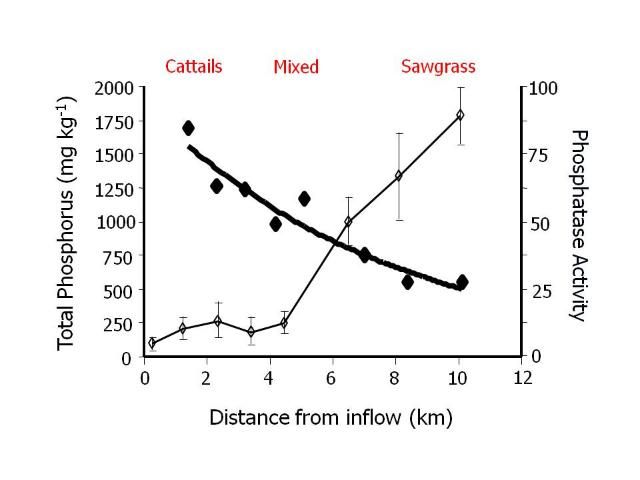Florida's diverse wetlands provide valuable functions, including water storage, recreation, and a habitat for wildlife. Most famous of these wetlands is the Everglades, a vast wetland historically encompassing most of Florida south of Lake Okeechobee. Events in the last hundred years, including urbanization and agriculture, have reduced the size of the Everglades considerably, with remnants being the heavily-managed water conservation areas (WCAs), stormwater treatment wetlands, and a National Refuge, Forest, and Park.
The objective of this document is to describe effects of nutrients in the Everglades and identify sensitive early-warning indicators of ecological changes. This information would be of interest to water managers and the general public.
The Everglades was drained to improve water control and provide land for urbanization and agriculture. These changes also brought about shifts from wetland to terrestrial vegetation, and subsequently many alterations to soil and water properties and processes. Fertilizer use in agricultural and urban areas throughout central and southern Florida and decomposition of the organic soils have enriched drainage waters leaving these areas. Runoff from these areas then can enter the Everglades wetlands causing an increase in the nutrient concentrations of soil and water.
The most evident results of the nutrient inputs is the replacement of the primary native sawgrass vegetation with cattails. This in turn has altered the ecosystem considerably. Changes include increases in soil accumulation, water quality, wildlife patterns, and other environmental effects. The shift from native vegetation to cattails takes many years to occur, but it may be possible to detect changes to the Everglades before vegetation can respond, thus enabling corrective action to be undertaken before more irreparable damage occurs.
Many soil and microbial properties are very sensitive to eutrophication, which is the process by which nutrient levels are increased resulting in significant ecological effects to wetlands. By identifying these sensitive factors and understanding how they respond to eutrophication, we can better protect the Everglades by utilizing these factors as early warning indicators before the more long-term ecosystem changes can be observed.
These soil and microbial properties and processes are collectively referred to as biogeochemical indicators (Wright et al., 2008). Examples include chemical properties such as nutrient concentrations in the soil and water column, physical properties such as soil density, and microbial properties, such as microbial biomass, enzyme activity, and microbial respiration. A more complete list of biogeochemical indicators is provided in Table 1. These indicators are readily impacted by nutrients, land use changes, alterations in hydrologic conditions and vegetation patterns, and other environmental influences.
It has been demonstrated that eutrophication of the Everglades initiates changes in these biogeochemical indicators, often before changes to vegetation are observed (Wright and Reddy, 2001). For example, changes in the Everglades wetlands caused by nutrient enrichment can be detected due to the shift from the native sawgrass slough prairies to a landscape dominated by cattails. However, these undesirable consequences took many years to develop and occur, by which time it was difficult to remedy the problem. Thus, it is advantageous to be able to detect changes in biogeochemical indicators before the long-term effects are observed. This would allow for increased opportunities to remedy the adverse environmental conditions before more irreversible changes occur to the ecosystem in the long-term.
Biogeochemical indicators have been successfully utilized in the Everglades by predicting the impacts of eutrophication (Wright and Reddy, 2001). In WCA-2a, external phosphorus loading increased phosphorus concentrations in soil and water, which corresponded to the areas experiencing displacement of sawgrass with cattail. The moving front of phosphorus into the marsh preceded cattail encroachment as evidenced by changes in biogeochemical indicators beyond the area of impact (Figure 1).

Alkaline phosphatase is an enzyme produced by algae and microorganisms for the purpose of sequestering phosphorus from the environment. Phosphatase shows an inverse relationship to phosphorus concentrations in soil and water, since high phosphorus concentrations decrease phosphatase activity. As such, phosphatase is a very sensitive indicator of eutrophication. The more pristine areas of WCA-2a have high phosphatase activity while the nutrient-impacted areas have low phosphatase activity (Figure 1). In fact, changes in phosphatase were observed before elevated soil phosphorus concentrations and vegetation shifts were observed, thus indicating that enzyme activity could be used to predict eutrophication. Therefore, it was concluded that microbial activity, expressly enzymes, were more sensitive indicators of eutrophication than soil chemical properties, which in turn were more sensitive than vegetation.
Such utilization of biogeochemical indicators has been applied to other wetland ecosystems for gauging early-warning stresses. Changes to ecosystems can be detected quickly and remedies can be sought before the changes become harder to rectify.
For more information, see:
Wright, A.L., and K.R. Reddy. 2001. Phosphorus loading effects on extracellular enzyme activity in Everglades wetland soils. Soil Sci. Soc. Am. J. 65:588-595.
Wright, A.L., K.R. Reddy, and S. Newman. 2008. Biogeochemical response of the Everglades landscape to eutrophication. Global J. Environ. Res. 2:102-109.